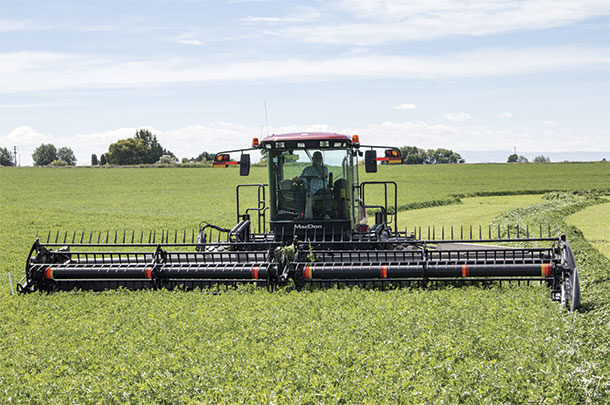Maintaining sufficiently high operating speeds also improves the timeliness of a harvest operation, allowing the producer to remain in the optimum weather and crop condition window to harvest the highest-quality forage. Average speeds for forage seeding and harvesting operations are included in (Table 1).

The standard deviation column is the range that includes two-thirds of operations. So for example, if the average mowing speed is 10.5 mph, then two-thirds of operators are mowing between 7 (10.5 - 3.5) and 14 (10.5 + 3.5) mph.
It should be emphasized: Actual field conditions will play a large role in determining harvesting speeds. Large, level and uniformly shaped fields can be harvested at higher speeds than small, disuniform fields. Increased operating speeds can improve an operation’s efficiency by recovering some time lost to turning in small non-uniformly shaped fields.
This is why we always encourage farmers to till fields to be seeded for a smooth surface. While one can easily establish an alfalfa field with no-till seeding into a previous corn field, unless the field is at least disked, the corn rows will make harvesting hay or haylage rough and may slow operations.
Farmers should also consider minimizing obstructions in fields to reduce wasted time and fuel working around them (and minimizing damage to machinery and repair costs).
The average mowing speed is 10.5 mph (Table 1). As we talk to farmers, most are harvesting within a standard deviation of this. Mowing is the limiting operation for most forage harvesting. In fact, as balers and choppers have increased in size, it generally takes two or more mowers to stay ahead of the harvester.
Machinery manufacturers are generally testing mowers at up to 25 mph. This would be for disc mowers; sickle bar mowers with reels are somewhat slower. Harvesting for haylage without a conditioner also allows for faster mowing speed. The auto-steer on many newer mowers may not increase speed but will increase harvesting efficiency by reducing skipped areas and mower overlaps.
Speed of merging is often limited, in addition to field smoothness, by efficient pickup of forage and tendency of pickup to throw forage (especially leaves) over the machine.
Rakes tend to have slower driving speeds than mergers due to the tendency to “throw” forage beyond windrows at higher speeds. A portion of operating speed is determined by speed/adjustments of power-driven rakes in relation to ground speed.
Higher driving and machine operating speeds may also increase leaf loss, which reduces tonnage harvested and quality of the harvested forage. We recommend a rake wide enough to merge at least two swaths. This reduces labor, fuel and wheel traffic on the field.
Round balers tend to be driven somewhat slower than medium square balers (3x4 feet) due to the need to stop and wrap each bale. The speed and number of bales made per hour are greatly affected by yield. The most efficient harvesting is achieved by harvesting windrows at the capacity of the baler.
Thus, swaths should be merged to make larger windrows. Merging swaths into bigger windrows also reduces wheel traffic from the tractor and baler, which minimizes yield loss of next growth due to traffic.
Denser bales (both square and round) result from slower field speed. On the flip side, smaller windrows or slower speed will result in more leaf loss.
The average speed for harvesters tends to be higher for hay than for corn silage due to the lower tonnage in most windrows compared to yield in the number of corn rows being harvested. It should be noted: In either case, fuel consumption is less and ground speed is greater for longer-cut lengths of forage.
As a general rule, longer chop length provides greater effective fiber for the animal, but chop length must be short enough to allow packing to adequate density (45 pounds per cubic foot). For corn, all kernels must be broken as adjusted by chop length and kernel processing.
In summary, while many factors determine the optimum field speed of each harvesting operation, faster harvesting generally means increased rate of harvest and reduced labor and fuel. ![]()
PHOTO: Cutting alfalfa. Photo by Chezney Olsen.
Brian Luck is an ag engineer with the University of Wisconsin.

-
Dan Undersander
- Forage Agronomist
- University of Wisconsin
- Email Dan Undersander













